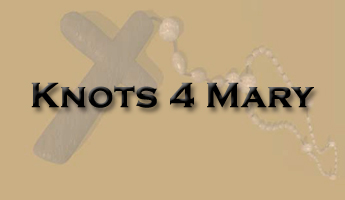


There are a few basic knots that you will need to learn how to tie to make a 'standard' Rosary. Many of the other sets of instructions you will find include only one basic 'barrel knot', but I tend to use two variants with four different sizes. This makes a better looking Rosary and makes them easier to use by feel and sight as you pray the Rosary. So here are the different basic knots as I have named them:
3 wrap half barrel knot - used for the Hail Mary beads
5 wrap full barrel knot - used for the Our Father beads
2 wrap double string full barrel knot - used for the junction of the 5 decade loop
6 wrap full barrel knot - multiples used to construct the Cross at the end of the Rosary
Single overhand knot - used to join the cross member of the Cross at the end of the Rosary.
First Question: I have seen a description of a barrel knot and it looks nothing like what you are using - what's up? OK a true barrel knot is a knot used to join two different lines together. It may also be called a fisherman's knot by some as it can be used to join a fish line to a leader line, etc. It is also used by climbers. The true barrel knot, sometimes called a blood knot, is a functional knot that will not slip or untie. The Ashley Book of Knots (the sailor's knot tyers bible) (Yes, I am a retired sailor that lived on my yacht and tied knots for years.) shows the barrel knot as seen below on the left. Now you will see that our Rosary 'barrel knot' is simply a single line version of the true barrel knot, and is a decorative knot rather than a functional knot.


Next question: What's the deal about a half barrel and full barrel knot? Well it's all in how you begin the knot. I'll show you the difference, but for now just know that the look of a Half Barrel knot looks more rounded at the beginning and the end which makes it look more like a 'rounded bead'. That's why we use them for the Hail Mary beads of the Rosary. The Full Barrel knot looks more square ay the beginning and end, so we use a longer version of the Full Barrel knot for the Our Father beads. Using spacing and size difference for the Our Father beads gives a much more functional Rosary.
Another question: Why use several 6 wrap knots for the Cross? Most other twine Rosaries that I have seen make a small cross at the end and it doesn't seem to match with the rest of the Rosary. The problem is that when you make a multi-wrapped barrel knot you can't get it tight enough if it is beyond 5 or 6 wraps. I wanted to make a cross with at least 10 wraps on the bottom section of the cross. As mentioned, it is difficult to get that many wraps tight enough to stay and after a short time, the cross becomes loose and floppy. So to make the bottom section of the cross we will use two 6 wrap full barrel knots tied as close together as we can get them. That makes the bottom of the cross 12 wraps long and we will make the top and two sides 6 wraps to match the bottom.
Ok Ok, all this jargon doesn't mean anything yet, so let's take a look and try some knots. You will need a test section of #36 twine and make sure that the ends have been melted and beveled. A couple of feet should work just fine. You will also need to have your Rosary Knotting Tool at hand. Now, I'm right handed and all my instructions are for those that are right handed. Remember that the twine you have, and that is generally available, has 3 left handed strands of yarn twisted together as right handed twine. Because of this structure it is better to make the knots right handed as you will see here. You can make them left handed by just reversing what you see, but know that the knots may not be as tight or lay as well.
Home Page - Glossary - About Us - Contact Us - Questions & Answers
©2017 Bob
Snyder
url: http://www.knots4mary.com/knots.html
First Created: 5/18/19 Last Updated:
05/20/19